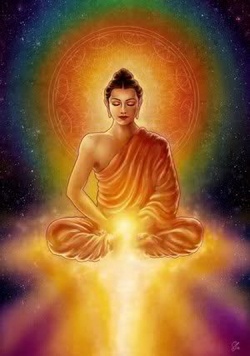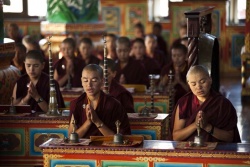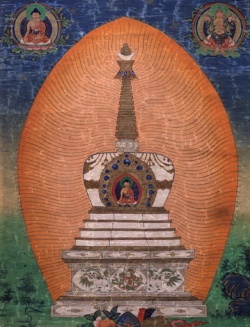Mati Paṇchen Lodro Gyeltsen
Mati Paṇchen Lodro Gyeltsen (sa bzang ma ti paN chen blo gros rgyal mtshan) was born in 1294 in the Ngari (mnga' ris) region of western Tibet. He was recognized very early as an emanation of the buddha Maitreya and is said to have been able to recite the Five Books of Maitreya from memory when he was four years old.
After some further studies in his home region, when he was fifteen years old Mati traveled to Nyetang (snye thang) monastery in U, where he received ordination as a novice monk from the abbot Tashi Sengge (bkra shis seng ge, d.u.), and to Ralung monastery (ra lung), where he mastered many scholastic subjects such as the monastic code, abhidharma, epistemology, and the Bodhisattvacaryāvatāra.
Then he arrived at the great monastery of Sakya (sa skya), where he studied under the master Jamyang Chokyi Gyeltsen ('jam dbyangs chos kyi rgyal mtshan), especially the Tantra Trilogy of Hevajra. He also visited other monasteries and masters, studying tantric subjects such as the Yamari cycles (gshed skor), the teachings of Zhije, the Six Dharmas of Naropa, and so forth.
While studying at Zhalu (zha lu) Monastery when he was twenty-five years old, Mati Paṇchen first heard about Dolpopa Sherab Gyeltsen (dol po pa shes rab rgyal mtshan, 1292-1361), was moved to tears, and made many prayers to meet him.
When Mati was able to travel to Jonang monastery, he auspiciously arrived one morning just as Dolpopa had finished his meditation session and the conch shell was being blown to announce the beginning of a teaching session.
He sat at the edge of a gathering of about two hundred monks as Dolpopa taught the great Vimalaprabhā commentary on the Kālacakra Tantra, incredibly supplementing it with explanations from the Prajñāpāramitā, epistemology, Abhidharma, and the monastic code.
Acording to his biography, Mati Paṇchen was delighted and thought, “Wherever I have traveled, I've never found a master like this lord of dharma,” and began to weep. Mati was seated at the edge of the assembly, and no one recognized him, but Dolpopa understood.
As soon as the teachings were finished, he sent for Mati, who was ceremoniously invited into Dolpopa's presence with incense and a parasol, and the master himself honored him. Mati prostrated and offered gifts, and Dolpopa treated him affectionately and kept him late in conversation.
From that day forward, Mati Paṇchen constantly remained with Dolpopa, receiving and mastering all the exoteric and esoteric teachings. He also studied many profound topics under Dolpopa's major disciples Kunpang Chodrak Pelzang (kun spangs chos grags dpal bzang, c.1283-c.1363) and Jonang Lotsāwa Lodro Pel (jo nang lo tsA wa blo gros dpal, 1299-1354). Mati
Paṇchen had also studied Sanskrit and other subjects with the great translator Pang Lotsāwa Lodro Tenpa (dpang lo tsA ba blo gros brtan pa, 1276-1342) and, in about 1334, Mati and Lodro Pel made a new revised translation of the Kālacakra Tantra and the Vimalaprabhā, which became known as the “new Jonang translation.”
The master Dawa Gyeltsen (zla ba rgyal mtshan, d.u.) invited Mati Paṇchen to teach at Sabzang Genden (sa bzang dga' ldan) monastery, and for one year he taught the Vimalaprabhā commentary on the Kālacakra Tantra.
Then the entire monastery was offered to him, he made it his residence, and a large number of monks gathered from many great monasteries to hear his teachings. Mati Paṇchen also told of having been the great translator Tropu Lotsāwa Jampa Pel (khro phu lo tsA ba byams pa dpal, 1172-c.1236) in a past life, and clairvoyantly identified objects he had brought back from India at that time, such as Nāgārjuna's meditation strap and Saraha's walking cane.
Miraculous events are said to have occurred at the time of Sabzang Mati Paṇchen's death, and marvelous images and relics appeared in his remains after cremation.
Sources
Gyal ba jo bzang dpal bzang po. 1992. Chos kyi rje kun mkhyen chen po yab sras bco lnga'i rnam thar nye bar bsdus pa ngo mtshar rab gsal. In The 'Dzam-thang Edition of the Collected Works (Gsung-'bum) of Kun-mkhyen Dol-po-pa Shes-rab rgyal-mtshan, Delhi: Shedrup Books, vol. 1: 559–629, pp. 577–82. The same work has also been published in Byang sems rgyal ba ye shes. 2004. Dpal ldan dus kyi 'khor lo jo nang pa'i lugs kyi bla ma brgyud pa'i rnam thar. Beijing: Mi rigs dpe skrun khang, 2004, 143–209.
Ngag dbang blo gros grags pa. 1992. Dpal ldan jo nang pa'i chos 'byung rgyal ba'i chos tshul gsal byed zla ba'i sgron me. Koko Nor: Krung go'i bod kyi shes rig dpe skrun khang, 1992, p. 33.
Cyrus Stearns
August 2008


